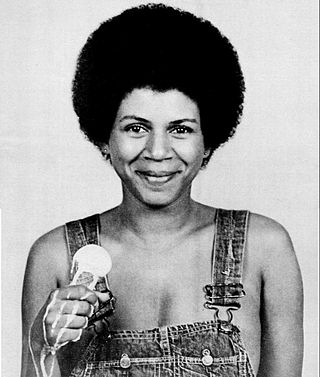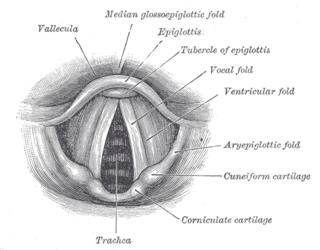Vocal range and voice classification
Vocal range plays such an important role in classifying singing voices into voice types that sometimes the two terms are confused with one another. A voice type is a particular kind of human singing voice perceived as having certain identifying qualities or characteristics; vocal range being only one of those characteristics. Other factors are vocal weight, vocal tessitura, vocal timbre, vocal transition points, physical characteristics, speech level, scientific testing, and vocal registration. All of these factors combined are used to categorize a singer's voice into a particular kind of singing use or voice type. [8]
The discipline of voice classification developed within European classical music and is not generally applicable to other forms of singing. Voice classification is often used within opera to associate possible roles with potential voices. There are several systems in use including the German Fach system, the Italian opera tradition, and French opera tradition. [1] There are other systems of classification as well, most commonly the choral music system. [9]
No system is universally applied or accepted. [10] Most of the voice types identified by such systems, however, are sub-types that fall under seven different major voice categories that are for the most part acknowledged across all of the major voice classification systems. [10] Women are typically divided into three main groups: soprano, mezzo-soprano, and contralto. Men are usually divided into four main groups: countertenor, tenor, baritone, and bass. When considering the pre-pubescent voices of children an eighth term, treble, can be applied. Within each of these major categories there are several sub-categories that identify specific vocal qualities like coloratura facility and vocal weight to differentiate between voices. [1]
Vocal range itself does not determine a singer's voice type. While each voice type does have a general vocal range associated with it, human singing voices may possess vocal ranges that encompass more than one voice type or are in between the typical ranges of two voice types. Therefore, voice teachers use vocal range as only one factor among many in classifying a singer's voice. [2] More important than range in voice classification is tessitura, or where the voice is most comfortable singing, and vocal timbre, or the characteristic sound of the singing voice. [1] For example, a female singer may have a vocal range that encompasses the low notes of a mezzo-soprano and the high notes of a soprano. A voice teacher would therefore look to see whether the singer was more comfortable singing higher, or lower. If she were more comfortable singing higher, then the teacher would probably classify her as a soprano. If the singer were more comfortable singing in the mid to lower part of their voice the teacher would probably classify her as a mezzo-soprano. The teacher would also consider the sound of the voice; sopranos tend to have a lighter and less rich vocal sound than a mezzo-soprano. A voice teacher, however, would never classify a singer in more than one voice type, regardless of the size of the vocal range of the singer. [2]
Operatic six basic voice types
Within the operatic systems of classification, there are six basic voice types. The ranges given below are approximations and are not meant to be too rigidly applied. [11] [ failed verification ]
- Soprano: the highest female voice typically between C4 and C6
- Mezzo-soprano: the middle female voice typically between A3 and A5
- Contralto: the lowest female voice typically between F3 and F5
- Tenor: the highest male voice typically between C3 and C5
- Baritone: the middle male voice typically between A2 and A4
- Bass: the lowest male voice typically between E2 and E4
| Scientific pitch name | Voice type's range | |||||
|---|---|---|---|---|---|---|
| C6 Soprano C (High C) | ||||||
| B5 | ||||||
| A♯5/B♭5 | ||||||
| A5 | ||||||
| G♯5/A♭5 | ||||||
| G5 | ||||||
| F♯5/G♭5 | ||||||
| F5 | ||||||
| E5 | ||||||
| D♯5/E♭5 | ||||||
| D5 | ||||||
| C♯5/D♭5 | ||||||
| C5 Tenor C | ||||||
| B4 | ||||||
| A♯4/B♭4 | ||||||
| A4 A440 | ||||||
| G♯4/A♭4 | ||||||
| G4 | ||||||
| F♯4/G♭4 | ||||||
| F4 | ||||||
| E4 | ||||||
| D♯4/E♭4 | ||||||
| D4 | ||||||
| C♯4/D♭4 | ||||||
| C4 Middle C | ||||||
| B3 | ||||||
| A♯3/B♭3 | ||||||
| A3 | ||||||
| G♯3/A♭3 | ||||||
| G3 | ||||||
| F♯3/G♭3 | ||||||
| F3 | ||||||
| E3 | ||||||
| D♯3/E♭3 | ||||||
| D3 | ||||||
| C♯3/D♭3 | ||||||
| C3 | ||||||
| B2 | ||||||
| A♯2/B♭2 | ||||||
| A2 | ||||||
| G♯2/A♭2 | ||||||
| G2 | ||||||
| F♯2/G♭2 | ||||||
| F2 | ||||||
| E2 | ||||||
| D♯2/E♭2 | ||||||
| D2 | ||||||
| C♯2/D♭2 | ||||||
| C2 Deep C | ||||||
Some men, in falsetto voice or as a result of certain rare physiological conditions, can sing in the same range as women. These do not fall into the female categories, instead called countertenors within classical music. Within contemporary music, however, the use of the term tenor for these male voices would be more appropriate. [2]
Within choral music there are only four categories for adult singers: soprano and alto for women, tenor and bass for men. [12]
In the UK, the term "male alto" refers to a man who uses falsetto vocal production to sing in the alto section of a chorus. This practice is much less common outside the UK where the term countertenor is more often applied. Countertenors are also widely employed within opera as solo vocalists, though the term "male alto" is never used to refer to a solo vocalist.
Children's voices, both male and female, are described as trebles, although boy soprano is widely used as well. [1]




